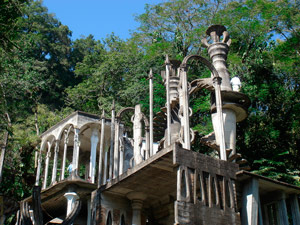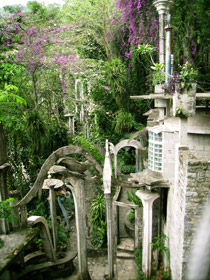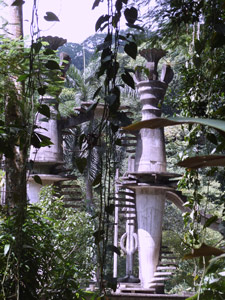At a site topped by a green foliage, deep in the jungle of Mexico’ s Huasteca, surrounded by a crushing humidity, Edward James, a wealthy man from Scotland, amateur painter, poet, writer and patron of artists arrived one day of 1950.
In 1944, one year before traveling to Mexico for the first time, James spent a lot of time absorbed in the learning of Buddhism, meditation and Vedanta–an orthodox philosophical system of India– under the guidance of Krishnamurti in Los Angeles, California, and accompanied by writer Aldous Huxley. This was the same person who showed part of Mexico to James after inviting him, along with psychologist Erich Fromm to take a rest at his house in Cuernavaca, in 1945.
 James went on his adventure in the north of the Republic in 1950, along with a young Mexican friend, Plutarco Gastelum. In his company, he submerged under the cool waters of all nine natural pools intercommunicated by a sinuous river with falls flowing down the wooded hills into the 30-hectare field of the coffee farm La Conchita, in the outskirts of the town of Xilitla, formerly called Taxiol Xilitla –sometimes translated as Place of Snails and others as Place of Pizahuales (a local plant)–, 87 Km away from Valles City, Tamaulipas, on a low-lying and warm land that spans along the coasts of the Gulf of Mexico.
James went on his adventure in the north of the Republic in 1950, along with a young Mexican friend, Plutarco Gastelum. In his company, he submerged under the cool waters of all nine natural pools intercommunicated by a sinuous river with falls flowing down the wooded hills into the 30-hectare field of the coffee farm La Conchita, in the outskirts of the town of Xilitla, formerly called Taxiol Xilitla –sometimes translated as Place of Snails and others as Place of Pizahuales (a local plant)–, 87 Km away from Valles City, Tamaulipas, on a low-lying and warm land that spans along the coasts of the Gulf of Mexico.
As he swam in the pools, he saw how one of the travelers accompanying him, Texan Roland Mckenzie, was covered by a colony of butterflies as a premonition, becoming then the “butterfly man.” Edward James had found his own sanctuary.
Having fallen in love with the place, James bought the farm and, little by little, he acquired more plots of land from the neighbors, and used them to grow 10,000 plants of orchids that, unfortunately, died in a winter day of 1963. It was then when Edward James (Edward Frank Willis James, born on August 16, 1907 in Gullane, Scotland, and dead from an abdominal stroke on December 2, 1984, in San Remo, Italy) started his Jungle Regency-like architectural dream built along seventeen years, starting in 1967 until he passed. He called it Garden of Eden. “I build–he said– just because I like to see beautiful things, because the living Mexican land suggested it to me. They were already there, I only materialize them. My ten thousand orchids died and I set out to create something more resistant that could endure the frosts.”
The building as such is an unfinished lushness, all cement and whispers that produce a melancholic effect. It provokes in the visitor astonishment and at the same time a slight feeling of fear and excitement. In order to fully enjoy the place it takes some time of adaptation to take in what is unclassifiable; monuments that do not match the patterns that one has learned throughout one’s life. The area, built in The Pools consists of 36 fanciful sculptural forms with a strong surrealistic influence based on the “certainty of chance”, only one of which was used as a home: the house where James lived, whose rooms included an eye-shaped swimming pool containing 50,000 gallons of water. The pupil served for the hot water and the rest for the cold water.
James’ creative spirit took him down different roads. The sculptural work that disregarded all the principles to make the most of materials and economic resources emerged, putting dreams over the rational use of the space, not orienting the work towards a specific end or function. He actually wrote a poem for it:
My house grows like the chamber’dnautilus;
After the storm opens a larger room from my
more intense childhood’s sleeping place… where curled,
my head to chest, I felt the grace….
of the first need to grow. My house has wings
and sometimes in the dead of night she sings.
 The work began with workers and carpenters Plutarco Gastelum recruited in town –sometimes there were up to 150 of them. James never turned to professionals for advice; he just drew his ideas on gray paper, his designs inspired on nature, an expression of his own obsessions that became wood-made molds used for swaying and cement filling. Those molds were patiently made by a local simple man named Jose Aguilar, who became his main carpenter.
The work began with workers and carpenters Plutarco Gastelum recruited in town –sometimes there were up to 150 of them. James never turned to professionals for advice; he just drew his ideas on gray paper, his designs inspired on nature, an expression of his own obsessions that became wood-made molds used for swaying and cement filling. Those molds were patiently made by a local simple man named Jose Aguilar, who became his main carpenter.
Fountains, lookouts, pavilions, arches, bridges, stairways and terraces began to appear. He built them by “pure megalomania”, having a marked preference for the offbeat over the harmonious, and for originality rather than for aesthetics. Hands come out from the grass; multicolor snakes protect the halls and fleurs-de-lis placed next to the buttresses that don’t balance the weight at all. About the curious hands made out of cement, Igor Stravinsky wrote: “He was unable to satisfy the insatiable whim of having hands sculpted, engraved, painted, embroidered, knitted and frequently made all over the place.”
With a preconceived plan for every space or for the whole work, giving free rein to his endless imagination, the workers, confused and disoriented, followed the English man’s fantasies; they were frustrated for having to leave one project unfinished to start a new one with other characteristics, though equally far from conventional patterns. In all of them, form was the only thing that mattered, usefulness was never considered. It was a free act of extravaganza, and a confirmation of another principle of surrealism, which deprived art from any functionality.
James took pleasure in immersing everyone around him in a frenetic activity even if it didn’t were for a specific end, but just to have the illusion of feeling like he was producing. Builders who worked with him and have lived to our days have stated: “He wouldn’t let us enjoy a finished work. The first work we started was supposed to be a house, then a movie hall so he could watch the Flash Gordon series –Don Eduardo’s favorite–, then came a sumptuous cage for one of the exotic animals he had brought over like lions, tigers, ocelots, parrots, flamingos and crocodiles that he kept everywhere. He called one of the buildings The Library and there was never a book there.”
Another worker, Maurilio Garcia Chavez, recalls: “They were all buildings made out of whim. The work was not even continuous because Don Eduardo spent 15 days or a month in Xilitla and then he would go away for long periods. If we didn’t receive further drawings by mail from Europe or Africa, the work was halted until his return. We used huge amounts of material at his order. We wasted a lot because of the weird forms he requested, but he was a man who didn’t feel sorry about the money (sic) and we paid us very well. We paid us a full pay on Saturdays. Back then, the day’s wage was from 1.50 to 2.00 pesos and he gave us 10.00 or more daily. That’s why we were very happy to work with him.”
He never stayed in La Huasteca for a long time, and towards the end of his life he would only come for a few months annually or every two years. But as soon as he hit the town he changed his European outfit and put on a pair of huaraches (leather-thong sandals) and a poncho. Using a walking stick at more than 70 years of age, with his long white beard floating in the air, he climbed up to the construction area to check on the progress of the work and contemplated with satisfaction the “all unfinished” work, as researcher Xavier Guzman Urbiola, who preferred to describe James’ work as oneiric rather than surrealistic, used to call it. He used to write notes in his notebooks for more drawings, more 18-meter-tall columns, more walls with tear-shaped holes, more endless stairs, more solidified dreams.
Little was known by those who helped him build his projects in Las Pozas of Edward James’s life outside Xilitla, and of the origin of his fortune. Perhaps Plutarco and his wife Marina were the closest he was to having a family. After Marina died of cancer in 1982, Edward James never returned to Xilitla.
 The fortune he used to fulfill his dreams came from the family of James’ mother, whose mother (according to James) was the legitimate daughter of King Edward vii who, when being the Prince of Gales in his youth, had fallen in love with his grandmother –Helen Forbes–, one of the five sisters of a wealthy but not a nobility family.
The fortune he used to fulfill his dreams came from the family of James’ mother, whose mother (according to James) was the legitimate daughter of King Edward vii who, when being the Prince of Gales in his youth, had fallen in love with his grandmother –Helen Forbes–, one of the five sisters of a wealthy but not a nobility family.
James grew up next to his sisters and the servants, and had little contact with his elegant mother, who wore Worth’ designs. The painful anecdote that stock in the poet’s mind was that of the day in which his mother asked for one of her children to go with her to the church. The maid dared to ask which one of them she wanted to take, to which the lady replied irritated: How should I know? The one that goes best with my blue dress!
Being the only son, James inherited absolutely all of his parent’s fortune which was later increased when a very rich uncle was trampled to death by an elephant in a safari in Africa. Growing immensely rich, he decided to dedicate his life to beauty: he became the patron of choreographer George Balanchine (1904-1983) and composer Igor Stravinsky (1882-1971), as well as the woman who later became his wife, Vienna Opera’s Prima Ballerina Ottilie “Tilly” Ether Losch.
It was precisely in promoting the career of the Austrian dancer, for whom he wrote scripts and hired musicians and set designers, when he started to mix with members of the surrealistic movement, especially with Max Ernst, Salvador Dali, Rene Magritte and Leonora Carrington.
James was also the sponsor of the avant-garde surrealist art magazine Minotaure edited in Paris by Albert Shira for thirteen sporadic issues that came out between 1933 and 1939. Meanwhile, he took some time to write a poetry book titled The bones of my hand and his novel God’s Gardener.
He always wanted to “surprise” in the way the members of the movement led by Andre Breton did; he wanted to dedicate his life to the unexpected, complicated business of enjoying existence. In Mexico City, he used to show up at his friends’ house for a visit carrying a snake around his neck until the day the animal squeeze him so tight he almost dies of suffocation. The Majestic hotel, at the main square of the city, frequently had him as a guest, and suffered his eccentricities.
Salvador Dali once told him: “You’re madder than all surrealists together” though he accepted James’s offer help in 1938 who offered to give him 1,000 dollars per month so that he could do less but better paintings. He kept pieces created by many of the artists from this movement in his 300-room West Dean castle in the rural area of Sussex, to the South of England, like his portrait from behind titled Reproduction Interdite, made by Belgian artist Rene Magritte (1898-1967).
In Xilitla, the reinforced concrete fit together by means of steel bars rose up over the tops of the trees in swollen-looking columns featuring stone shoots and blossoms, as if they followed their own genetic impulse, mimicking leaves, resembling trunks in an “architecture assembled into nature,” as the eccentric builder described it. The plain concrete was painted in green and yellow tones, or embellished with colorful stones. Gardens surrounded by walls enclosing other gardens emerged: “mazes of solidified wishes” (catalogue of the Grand International Surrealist Exhibition held in Paris, France, in 1938).
Doors that open to a solid wall appeared, as well as stairs that led to nowhere and ended into space; they are the dwellers of the forest making company to the ferns, the fig trees and the sycamores, the red cedar and the chalchihuite, as well as the wild flowers of the area called chicos among which choral snakes slither.
The rooms designed by James are forever open to the light and the singing of the birds. The buildings grew taller protecting the trees, without destroying the environment, while their owner walked lonely under the shades at the end of the day. And he baptized them with poetical names: House of three stories that could be five; House with a roof resembling a whale; Fleur-de-lis Bridge and Cornucopia.
A common feature of the houses is the very narrow doors designed, according to the owner, “to keep big people outside”, and the low murmur of the water flowing into the pools, going on in the river and down the falls. The light enters through the pane-lacking windows, along with the bird’s trill and the sweet-smelling air of the jungle.
Un-walled and equally lacking function and furniture, the highest building was the so-called House of three stories that could be five, which recalls M.C. Escher’s unforgettable visual concepts (1898-1972) or those from Catalan architect Antoni Gaudí (1852-1926). From there, the emerald scene of the setting that envelops until nearly hiding the materialization of the English poet’s dream can be enjoyed.
At present, the colors of the paint of buildings have almost faded away. The unfinished walls are crowned by rusty steel bars. The animals are gone and the jungle is devouring the zone and semi-burying the dreamy designs. Just as Juan Manuel Rivera Madrid says “it is awkward to think that humans have always dreamt of building for eternity. All the peoples have seen peoples fall and cities reduced to ashes. Nothing lasts forever. There is a monumental idiocy in every triumphal arch.”
Related Publications

How Harumi Yamaguchi invented the modern woman in Japan
March 16, 2022












